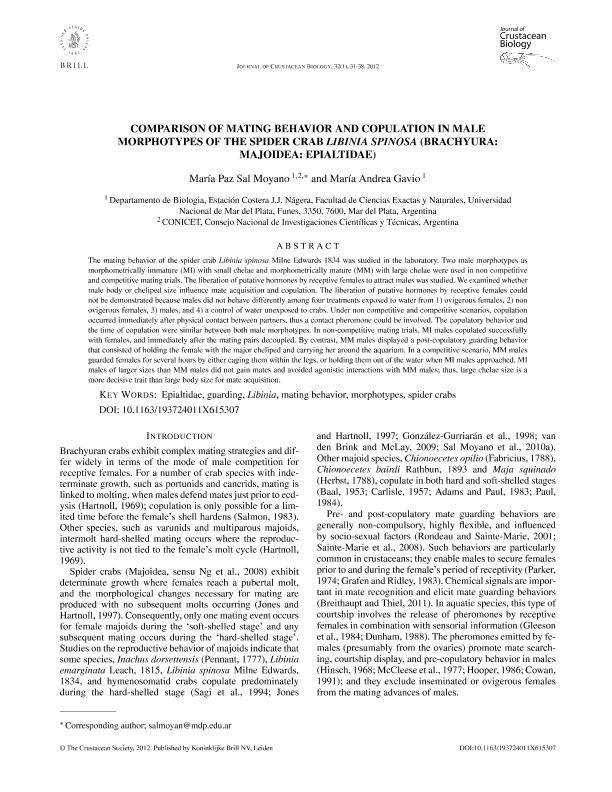Artículo
Comparison of mating behavior and copulation in male morphotypes of the spider crab Libinia spinosa (Brachyura: Majoidea: Epialtidae)
Fecha de publicación:
02/2012
Editorial:
Crustacean Society
Revista:
Journal of Crustacean Biology
ISSN:
0278-0372
Idioma:
Inglés
Tipo de recurso:
Artículo publicado
Clasificación temática:
Resumen
The mating behavior of the spider crab Libinia spinosa Milne Edwards 1834 was studied in the laboratory. Two male morphotypes as morphometrically immature (MI) with small chelae and morphometrically mature (MM) with large chelae were used in non competitive and competitive mating trials. The liberation of putative hormones by receptive females to attract males was studied. We examined whether male body or cheliped size influence mate acquisition and copulation. The liberation of putative hormones by receptive females could not be demonstrated because males did not behave differently among four treatments exposed to water from 1) ovigerous females, 2) non ovigerous females, 3) males, and 4) a control of water unexposed to crabs. Under non competitive and competitive scenarios, copulation occurred immediately after physical contact between partners, thus a contact pheromone could be involved. The copulatory behavior and the time of copulation were similar between both male morphotypes. In non-competitive mating trials, MI males copulated successfully with females, and immediately after the mating pairs decoupled. By contrast, MM males displayed a post-copulatory guarding behavior that consisted of holding the female with the major cheliped and carrying her around the aquarium. In a competitive scenario, MM males guarded females for several hours by either caging them within the legs, or holding them out of the water when MI males approached. MI males of larger sizes than MM males did not gain mates and avoided agonistic interactions with MM males; thus, large chelae size is a more decisive trait than large body size for mate acquisition.
Palabras clave:
EPIALTIDAE
,
GUARDING
,
LIBINIA
,
MATING BEHAVIOR
,
MORPHOTYPES
,
SPIDER CRABS
Archivos asociados
Licencia
Identificadores
Colecciones
Articulos(IIMYC)
Articulos de INSTITUTO DE INVESTIGACIONES MARINAS Y COSTERAS
Articulos de INSTITUTO DE INVESTIGACIONES MARINAS Y COSTERAS
Citación
Sal Moyano, María Paz; Gavio, Maria Andrea; Comparison of mating behavior and copulation in male morphotypes of the spider crab Libinia spinosa (Brachyura: Majoidea: Epialtidae); Crustacean Society; Journal of Crustacean Biology; 32; 1; 2-2012; 31-38
Compartir
Altmétricas




